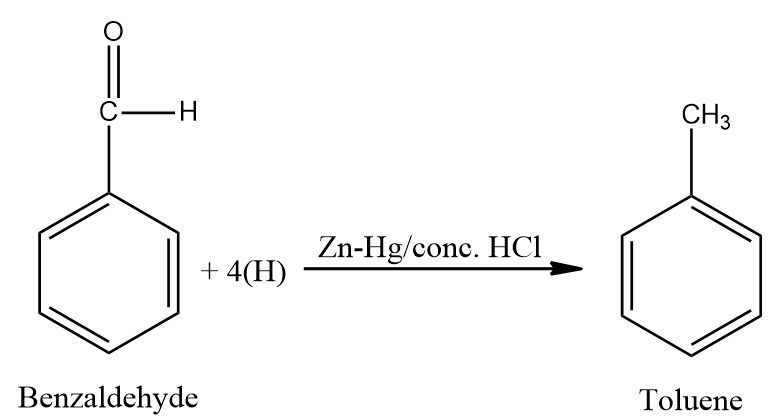
Answer
468.6k+ views
Hint: Clemmenson’s reduction is a reduction reaction which involves formation of saturated hydrocarbons from carbonyl compounds. This reaction is similar to Wolff-Kishner reduction reaction except for the reagents and catalysts used and the pH conditions.
Complete step by step answer:
- In Clemmenson’s reduction, aldehydes or ketones which are not sensitive to acids are reduced to alkanes when heated with zinc amalgam and concentrated hydrochloric acid.
- Clemmenson’s reduction is a deoxygenation reaction which involves removal of oxygen from carbonyl compounds to form alkanes.
- In this reaction, $C=O$ is reduced to $-C{{H}_{2}}-$ group.
- Clemmenson’s reduction is most commonly used to convert acyl benzenes to alkyl benzenes.

- Benzaldehyde undergoes Clemmenson’s reduction in the presence of zinc amalgam and concentrated hydrochloric acid to form toluene.
- One more example can be conversion of acetone to n-propane.

- Wolff-Kishner reduction reaction is also similar to Clemmenson’s reduction reaction.
- In Wolff-Kishner reduction reaction, carbonyl compounds are heated with hydrazine and potassium hydroxide or potassium tert-butoxide in presence of boiling solvents such as ethylene glycol or diethylene glycol to give alkanes.
- First the carbonyl compounds react with hydrazine to form hydrazine which on heating under basic conditions gives alkane with evolution of nitrogen gas.

- The only difference in both the reactions is the reaction conditions and the catalysts used.
Note: Remember Clemmenson’s reaction is a deoxygenation reaction in which carbonyl compounds are reduced to alkanes. Clemmenson’s reaction and Wolff –Kishner reaction yield the same final product. The difference between the two reactions is that Clemmenson’s reaction takes place in acidic condition in the presence of zinc amalgam and heat and Wolff-Kishner’s reaction takes place in basic conditions in the presence of hydrazine and solvent ethylene glycol.
Complete step by step answer:
- In Clemmenson’s reduction, aldehydes or ketones which are not sensitive to acids are reduced to alkanes when heated with zinc amalgam and concentrated hydrochloric acid.
- Clemmenson’s reduction is a deoxygenation reaction which involves removal of oxygen from carbonyl compounds to form alkanes.
- In this reaction, $C=O$ is reduced to $-C{{H}_{2}}-$ group.
- Clemmenson’s reduction is most commonly used to convert acyl benzenes to alkyl benzenes.

- Benzaldehyde undergoes Clemmenson’s reduction in the presence of zinc amalgam and concentrated hydrochloric acid to form toluene.
- One more example can be conversion of acetone to n-propane.

- Wolff-Kishner reduction reaction is also similar to Clemmenson’s reduction reaction.
- In Wolff-Kishner reduction reaction, carbonyl compounds are heated with hydrazine and potassium hydroxide or potassium tert-butoxide in presence of boiling solvents such as ethylene glycol or diethylene glycol to give alkanes.
- First the carbonyl compounds react with hydrazine to form hydrazine which on heating under basic conditions gives alkane with evolution of nitrogen gas.

- The only difference in both the reactions is the reaction conditions and the catalysts used.
Note: Remember Clemmenson’s reaction is a deoxygenation reaction in which carbonyl compounds are reduced to alkanes. Clemmenson’s reaction and Wolff –Kishner reaction yield the same final product. The difference between the two reactions is that Clemmenson’s reaction takes place in acidic condition in the presence of zinc amalgam and heat and Wolff-Kishner’s reaction takes place in basic conditions in the presence of hydrazine and solvent ethylene glycol.
Recently Updated Pages
How is abiogenesis theory disproved experimentally class 12 biology CBSE

What is Biological Magnification

Which of the following reagents cannot distinguish class 12 chemistry CBSE

Which of the following reagents cannot distinguish class 12 chemistry CBSE

Which of the following reagents cannot distinguish class 12 chemistry CBSE

Which of the following reagents cannot distinguish class 12 chemistry CBSE

Trending doubts
Which are the Top 10 Largest Countries of the World?

What is the definite integral of zero a constant b class 12 maths CBSE

Differentiate between homogeneous and heterogeneous class 12 chemistry CBSE

What are the major means of transport Explain each class 12 social science CBSE

Explain sex determination in humans with the help of class 12 biology CBSE

How much time does it take to bleed after eating p class 12 biology CBSE




